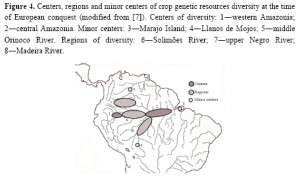- Resource list for setting up a school garden. Take that, Flanagan.
- Gary “Eco-gastronaut” Nabhan goes viral.
- Smithsonian goes native. Trees, that is.
- GRAIN video delves into origin of H1N1.
- There are boar farms of England?
- Nutrition advice needs to take genetics into account.
- Tracing the changing morphology of British post-medieval sheep. Well, someone has to do it.
- Thai floating market. A tourist trap, I know. But photogenic.
- Kew’s plant of the day is gum arabic. Wait, Kew has a plant of the day? Is there no end to their ingenuity?
- And GlobalDiv has a Breed of the Month. BTW, the same source has a thing on the XVIII Plant and Animal Genome Conference (Jan. 2010).
- Diverse diet for healthier bees, says BBC
- Breeding bovines in Asia.
- Cursed quinoa.
Amazonian agriculture analyzed
I don’t know about you, but in my laziness I sometimes catch myself making the assumption that a centre of crop origin is also one of crop diversity. That is of course sometimes the case, but by no means always, as Vavilov himself recognized. A recent open access paper in Diversity makes the point very clearly. 1
The authors, led by Charles R. Clement of the Instituto Nacional de Pesquisas da Amazônia in Manaus, review molecular studies and also bring in archaeological and other evidence in their discussion of the history of Amazonian crops. They come to the conclusion that these crops originated around the periphery of the region: “All but one of the species examined originated in the periphery of Amazonia (Figure 3), rather than along the major white water rivers where pre-conquest population densities were greatest.” Here’s that Fig. 3:
Now, in contrast, here’s where the pre-Columbian hotspots of diversity were to be found: “The major centers and regions of diversity are along the major white water rivers and in northwestern Amazonia, where ethnic diversity is extremely high.”
The explanation, according to the authors, is the length of time involved in the development of agriculture in the region.
Because crop domestication began thousands of years before food production systems became important, it is not at all surprising to see a dramatic contrast such as that in Amazonia.
Why was the Amazonian periphery such a focus of domestication?
It is possible that sufficient natural resources were available [in central Amazonia] so that the home gardens were such a small fraction of subsistence that they are difficult to find in the archaeological record. In contrast, in the headwaters of the same rivers in the periphery, less abundant aquatic resources may have increased the importance of home gardens.
Banana improvement at IITA explained
IITA has uploaded to youtube a longish interview with renowned banana expert Prof. Ivan Buddenhagen of UC Davis. Lots of fascinating insights, both technical and historical. What for me was the money quote comes at the beginning of the second installment (of five). Asked about what direction banana improvement should take at IITA, he says: “The first thing is to get more germplasm.” Thanks to Jacob for the tip.
Nibbles: Vavilov on couscous, Molecular studentships, Goat genetics, Svalbard Global Seed Vault, Sweet potato, New Agriculturist, Vietnam and CC, Liberian ag research, Cuisine
- Couscous deconstructed.
- China and Bioversity collaborate on molecular marker training.
- Neolithic legging helps unravel the history of the goat in Europe.
- Dag’s cool Svalbard pix.
- CIP launches Sweetpotato Action for Security and Health in Africa (SASHA).
- The new New Agriculturist does markets.
- Climate change and rice cultivation in the Mekong Delta.
- The perils of agricultural research in Liberia: one trial up in smoke, another stolen. Bummer.
- Ok, I had no idea there was a Tasting Cultures Foundation. Thanks, Facebook.
Nibbles: Goldman Environmental Prize, UK networking, European landraces publication, Seed Warriors, India agrobiodiversity sites, Beer books, Teosinte, Drought foods, Sugarcane genebank, Regional genebank in South Asia, Rhubarb, Annals, Food articles, Cryo
- Goldman Prizewinner Jesús León Santos: “It is time we recognize that traditional agricultural methods can make strong contributions to biodiversity conservation. We should encourage it and value it as a way to produce healthy foods that conserve and care for the environment.” Time indeed.
- British twofer: The Food Climate Research Network aims “to better understand how the food system contributes to greenhouse gas emissions, and to research and promote ways of reducing them.” Then there’s the Foresight Project on Global Food and Farming Futures. Will they talk to each other, I wonder.
- From Bioversity, “European landraces: on-farm conservation, management and use.” I wonder if the Foresight Project will download a copy.
- The “Seed Warriors” trailer. Oscar buzz, I hear.
- Agricultural biodiversity heritage sites in India. Ethnobotanist brings together information on food plants used during drought. Mashup, anyone?
- A book about beer. My two favourite things. Oooh, here’s another couple! And it’s not over: Spiegel weighs in on the old chestnut about beer being the reason for agriculture. My tankard runneth over.
- CIMMYT team monitors teosinte. Teosinte planning to fight back.
- Regional sugarcane genebank is actually being used! Heartwarming. Oh, and, coincidentally, here’s a history of Indian sugarcane breeding.
- “A SAARC Plant Genetic Resource Bank for rice, wheat and maize may be created to facilitate free exchange of germplasm between the member countries. To begin with, the Indian Gene Bank facilities may be utilized, with suitable modalities.” Not so heartwarming.
- The Russian roots of Alaskan rhubarb. Take that, Palin! Note the bit about St Isaac’s Cathedral, which of course sits opposite VIR. How apposite is that?
- Nigel Chaffey rounds up the usual suspects in presenting a potpourri of “plant-based items from the world’s media” for Annals of Botany. May well be one to watch. And not just because genebanks make an appearance.
- Amazing food roundup.
- Cryopreserving Chip, the Tennessee fainting goat.

